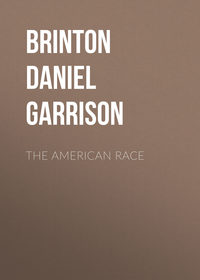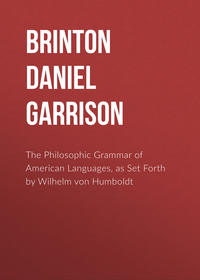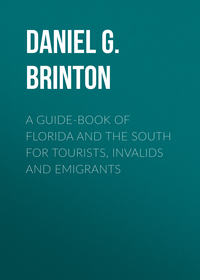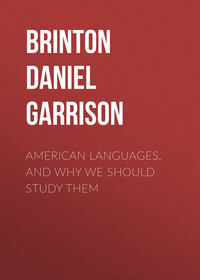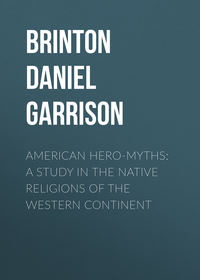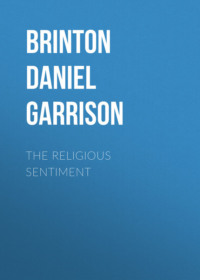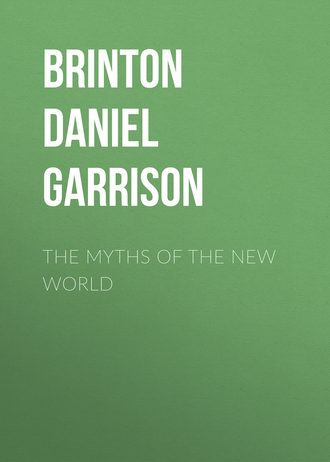 полная версия
полная версияThe Myths of the New World
These craven fears do but reveal the natural repugnance of the animal to a cessation of existence, and arise from the instinct of self-preservation essential to organic life. Other rites, undertaken avowedly for the behoof of the soul, prove and illustrate a simple but unshaken faith in its continued existence after the decay of the body.
None of these is more common or more natural than that which attributes to the emancipated spirit the same wants that it felt while on earth, and with loving foresight provides for their satisfaction. Clothing and utensils of war and the chase were, in ancient times, uniformly placed by the body, under the impression that they would be of service to the departed in his new home. Some few tribes in the far west still retain the custom, but most were soon ridiculed into its neglect, or were forced to omit it by the violation of tombs practised by depraved whites in hope of gain. To these harmless offerings the northern tribes often added a dog slain on the grave; and doubtless the skeletons of these animals in so many tombs in Mexico and Peru point to similar customs there. It had no deeper meaning than to give a companion to the spirit in its long and lonesome journey to the far off land of shades. The peculiar appropriateness of the dog arose not only from the guardianship it exerts during life, but further from the symbolic signification it so often had as representative of the goddess of night and the grave.
Where a despotic form of government reduced the subject almost to the level of a slave and elevated the ruler almost to that of a superior being, not animals only, but men, women, and children were frequently immolated at the tomb of the cacique. The territory embraced in our own country was not without examples of this horrid custom. On the lower Mississippi, the Natchez Indians brought it with them from Central America in all its ghastliness. When a sun or chief died, one or several of his wives and his highest officers were knocked on the head and buried with him, and at such times the barbarous privilege was allowed to any of the lowest caste to at once gain admittance to the highest by the deliberate murder of their own children on the funeral pyre—a privilege which respectable writers tell us human beings were found base enough to take advantage of.362
Oviedo relates that in the province of Guataro, in Guatemala, an actual rivalry prevailed among the people to be slain at the death of their cacique, for they had been taught that only such as went with him would ever find their way to the paradise of the departed.363 Theirs was therefore somewhat of a selfish motive, and only in certain parts of Peru, where polygamy prevailed, and the rule was that only one wife was to be sacrificed, does the deportment of husbands seem to have been so creditable that their widows actually disputed one with another for the pleasure of being buried alive with the dead body, and bearing their spouse company to the other world.364 Wives who have found few parallels since the famous matron of Ephesus!
The fire built nightly on the grave was to light the spirit on his journey. By a coincidence to be explained by the universal sacredness of the number, both Algonkins and Mexicans maintained it for four nights consecutively. The former related the tradition that one of their ancestors returned from the spirit land and informed their nation that the journey thither consumed just four days, and that collecting fuel every night added much to the toil and fatigue the soul encountered, all of which could be spared it by the relatives kindling nightly a fire on the grave. Or as Longfellow has told it:—
“Four days is the spirit’s journeyTo the land of ghosts and shadows,Four its lonely night encampments.Therefore when the dead are buried,Let a fire as night approachesFour times on the grave be kindled,That the soul upon its journeyMay not grope about in darkness.”The same length of time, say the Navajos, does the departed soul wander over a gloomy marsh ere it can discover the ladder leading to the world below, where are the homes of the setting and the rising sun, a land of luxuriant plenty, stocked with game and covered with corn. To that land, say they, sink all lost seeds and germs which fall on the earth and do not sprout. There below they take root, bud, and ripen their fruit.365
After four days, once more, in the superstitions of the Greenland Eskimos, does the soul, for that term after death confined in the body, at last break from its prison-house and either rise in the sky to dance in the aurora borealis or descend into the pleasant land beneath the earth, according to the manner of death.366
That there are logical contradictions in this belief and these ceremonies, that the fire is always in the same spot, that the weapons and utensils are not carried away by the departed, and that the food placed for his sustenance remains untouched, is very true. But those who would therefore argue that they were not intended for the benefit of the soul, and seek some more recondite meaning in them as “unconscious emblems of struggling faith or expressions of inward emotions,”367 are led astray by the very simplicity of their real intention. Where is the faith, where the science, that does not involve logical contradictions just as gross as these? They are tolerable to us merely because we are used to them. What value has the evidence of the senses anywhere against a religious faith? None whatever. A stumbling block though this be to the materialist, it is the universal truth, and as such it is well to accept it as an experimental fact.
The preconceived opinions that saw in the meteorological myths of the Indian, a conflict between the Spirit of Good and the Spirit of Evil, have with like unconscious error falsified his doctrine of a future life, and almost without an exception drawn it more or less in the likeness of the Christian heaven, hell, and purgatory. Very faint traces of any such belief except where derived from the missionaries are visible in the New World. Nowhere was any well-defined doctrine that moral turpitude was judged and punished in the next-world. No contrast is discoverable between a place of torments and a realm of joy; at the worst but a negative castigation awaited the liar, the coward, or the niggard. The typical belief of the tribes of the United States was well expressed in the reply of Esau Hajo, great medal chief and speaker for the Creek nation in the National Council, to the question, Do the red people believe in a future state of rewards and punishments? “We have an opinion that those who have behaved well are taken under the care of Esaugetuh Emissee, and assisted; and that those who have behaved ill are left to shift for themselves; and that there is no other punishment.”368
Neither the delights of a heaven on the one hand, nor the terrors of a hell on the other, were ever held out by priests or sages as an incentive to well-doing, or a warning to the evil-disposed. Different fates, indeed, awaited the departed souls, but these rarely, if ever, were decided by their conduct while in the flesh, but by the manner of death, the punctuality with which certain sepulchral rites were fulfilled by relatives, or other similar arbitrary circumstance beyond the power of the individual to control. This view, which I am well aware is directly at variance with that of all previous writers, may be shown to be that natural to the uncultivated intellect everywhere, and the real interpretation of the creeds of America. Whether these arbitrary circumstances were not construed to signify the decision of the Divine Mind on the life of the man, is a deeper question, which there is no means at hand to solve.
Those who have complained of the hopeless confusion of American religions have but proven the insufficiency of their own means of analyzing them. The uniformity which they display in so many points is nowhere more fully illustrated than in the unanimity with which they all point to the sun as the land of the happy souls, the realm of the blessed, the scene of the joyous hunting-grounds of the hereafter. Its perennial glory, its comfortable warmth, its daily analogy to the life of man, marked its abode as the pleasantest spot in the universe. It matters not whether the eastern Algonkins pointed to the south, others of their nation, with the Iroquois and Creeks, to the west, or many tribes to the east, as the direction taken by the spirit; all these myths but mean that its bourn is the home of the sun, which is perhaps in the Orient whence he comes forth, in the Occident where he makes his bed, or in the South whither he retires in the chilling winter. Where the sun lives, they informed the earliest foreign visitors, were the villages of the deceased, and the milky way which nightly spans the arch of heaven, was, in their opinion, the road that led thither, and was called the path of the souls (le chemin des ames).369 To hueyu ku, the mansion of the sun, said the Caribs, the soul passes when death overtakes the body.370 Our knowledge is scanty of the doctrines taught by the Incas concerning the soul, but this much we do know, that they looked to the sun, their recognized lord and protector, as he who would care for them at death, and admit them to his palaces. There—not, indeed, exquisite joys—but a life of unruffled placidity, void of labor, vacant of strong emotions, a sort of material Nirvana, awaited them.371 For these reasons, they, with most other American nations, interred the corpse lying east and west, and not as the traveller Meyen has suggested,372 from the reminiscences of some ancient migration. Beyond the Cordilleras, quite to the coast of Brazil, the innumerable hordes who wandered through the sombre tropical forests of that immense territory, also pointed to the west, to the region beyond the mountains, as the land where the souls of their ancestors lived in undisturbed serenity; or, in the more brilliant imaginations of the later generations, in a state of perennial inebriety, surrounded by infinite casks of rum, and with no white man to dole it out to them.373 The natives of the extreme south, of the Pampas and Patagonia, suppose the stars are the souls of the departed. At night they wander about the sky, but the moment the sun rises they hasten to the cheerful light, and are seen no more until it disappears in the west. So the Eskimo of the distant north, in the long winter nights when the aurora bridges the sky with its changing hues and arrowy shafts of light, believes he sees the spirits of his ancestors clothed in celestial raiment, disporting themselves in the absence of the sun, and calls the phenomenon the dance of the dead.
The home of the sun was the heaven of the red man; but to this joyous abode not every one without distinction, no miscellaneous crowd, could gain admittance. The conditions were as various as the national temperaments. As the fierce gods of the Northmen would admit no soul to the banquets of Walhalla but such as had met the “spear-death” in the bloody play of war, and shut out pitilessly all those who feebly breathed their last in the “straw death” on the couch of sickness, so the warlike Aztec race in Nicaragua held that the shades of those who died in their beds went downward and to naught; but of those who fell in battle for their country to the east, “to the place whence comes the sun.”374 In ancient Mexico not only the warriors who were thus sacrificed on the altar of their country, but with a delicate and poetical sense of justice that speaks well for the refinement of the race, also those women who perished in child-birth, were admitted to the home of the sun. For are not they also heroines in the battle of life? Are they not also its victims? And do they not lay down their lives for country and kindred? Every morning, it was imagined, the heroes came forth in battle array, and with shout and song and the ring of weapons, accompanied the sun to the zenith, where at every noon the souls of the mothers, the Cihuapipilti, received him with dances, music, and flowers, and bore him company to his western couch.375 Except these, none—without, it may be, the victims sacrificed to the gods, and this is doubtful—were deemed worthy of the highest heaven.
A mild and unwarlike tribe of Guatemala, on the other hand, were persuaded that to die by any other than a natural death was to forfeit all hope of life hereafter, and therefore left the bodies of the slain to the beasts and vultures.
The Mexicans had another place of happiness for departed souls, not promising perpetual life as the home of the sun, but unalloyed pleasure for a certain term of years. This was Tlalocan, the realm of the god of rains and waters, the terrestrial paradise, whence flowed all the rivers of the earth, and all the nourishment of the race. The diseases of which persons died marked this destination. Such as were drowned, or struck by lightning, or succumbed to humoral complaints, as dropsies and leprosy, were by these tokens known to be chosen as the subjects of Tlaloc. To such, said the natives, “death is the commencement of another life, it is as waking from a dream, and the soul is no more human but divine (teot).” Therefore they addressed their dying in terms like these: “Sir, or lady, awake, awake; already does the dawn appear; even now is the light approaching; already do the birds of yellow plumage begin their songs to greet thee; already are the gayly-tinted butterflies flitting around thee.”376
Before proceeding to the more gloomy portion of the subject, to the destiny of those souls who were not chosen for the better part, I must advert to a curious coincidence in the religious reveries of many nations which finds its explanation in the belief that the house of the sun is the home of the blessed, and proves that this was the first conception of most natural religions. It is seen in the events and obstacles of the journey to the happy land. We everywhere hear of a water which the soul must cross, and an opponent, either a dog or an evil spirit, which it has to contend with. We are all familiar with the dog Cerberus (called by Homer simply “the dog”), which disputed the passage of the river Styx over which the souls must cross; and with the custom of the vikings, to be buried in a boat so that they might cross the waters of Ginunga-gap to the inviting strands of Godheim. Relics of this belief are found in the Koran which describes the bridge el Sirat, thin as a hair and sharp as a scimetar, stretched in a single span from heaven to earth; in the Persian legend, where the rainbow arch Chinevad is flung across the gloomy depths between this world and the home of the happy; and even in the current Christian allegory which represents the waters of the mythical Jordan rolling between us and the Celestial City.
How strange at first sight does it seem that the Hurons and Iroquois should have told the earliest missionaries that after death the soul must cross a deep and swift river on a bridge formed by a single slender tree most lightly supported, where it had to defend itself against the attacks of a dog?377 If only they had expressed this belief, it might have passed for a coincidence merely. But the Athapascas (Chepewyans) also told of a great water, which the soul must cross in a stone canoe; the Algonkins and Dakotas, of a stream bridged by an enormous snake, or a narrow and precipitous rock, and the Araucanians of Chili of a sea in the west, in crossing which the soul was required to pay toll to a malicious old woman. Were it unluckily impecunious, she deprived it of an eye.378 With the Aztecs this water was called Chicunoapa, the Nine Rivers. It was guarded by a dog and a green dragon, to conciliate which the dead were furnished with slips of paper by way of toll. The Greenland Eskimos thought that the waters roared through an unfathomable abyss over which there was no other bridge than a wheel slippery with ice, forever revolving with fearful rapidity, or a path narrow as a cord with nothing to hold on by. On the other side sits a horrid old woman gnashing her teeth and tearing her hair with rage. As each soul approaches she burns a feather under its nose; if it faints she seizes it for her prisoner, but if the soul’s guardian spirit can overcome her, it passes through in safety.379
The similarity to the passage of the soul across the Styx, and the toll of the obolus to Charon is in the Aztec legend still more striking, when we remember that the Styx was the ninth head of Oceanus (omitting the Cocytus, often a branch of the Styx). The Nine Rivers probably refer to the nine Lords of the Night, ancient Aztec deities guarding the nocturnal hours, and introduced into their calendar. The Tupis and Caribs, the Mayas and Creeks, entertained very similar expectations.
We are to seek the explanation of these wide-spread theories of the soul’s journey in the equally prevalent tenet that the sun is its destination, and that that luminary has his abode beyond the ocean stream, which in all primitive geographies rolls its waves around the habitable land. This ocean stream is the water which all have to attempt to pass, and woe to him whom the spirit of the waters, represented either as the old woman, the dragon, or the dog of Hecate, seizes and overcomes. In the lush fancy of the Orient, the spirit of the waters becomes the spirit of evil, the ocean stream the abyss of hell, and those who fail in the passage the damned, who are foredoomed to evil deeds and endless torture.
No such ethical bearing as this was ever assigned the myth by the red race before they were taught by Europeans. Father Brebeuf could only find that the souls of suicides and those killed in war were supposed to live apart from the others; “but as to the souls of scoundrels,” he adds, “so far from being shut out, they are the welcome guests, though for that matter if it were not so, their paradise would be a total desert, as Huron and scoundrel (Huron et larron) are one and the same.”380 When the Minnetarees told Major Long and the Mannicicas of the La Plata the Jesuits,381 that the souls of the bad fell into the waters and were swept away, these are, beyond doubt, attributable either to a false interpretation, or to Christian instruction. No such distinction is probable among savages. The Brazilian natives divided the dead into classes, supposing that the drowned, those killed by violence, and those yielding to disease, lived in separate regions; but no ethical reason whatever seems to have been connected with this.382 If the conception of a place of moral retribution was known at all to the race, it should be found easily recognizable in Mexico, Yucatan, or Peru. But the so-called “hells” of their religions have no such significance, and the spirits of evil, who were identified by early writers with Satan, no more deserve the name than does the Greek Pluto.
Çupay or Supay, the Shadow, in Peru was supposed to rule the land of shades in the centre of the earth. To him went all souls not destined to be the companions of the Sun. This is all we know of his attributes; and the assertion of Garcilasso de la Vega, that he was the analogue of the Christian Devil, and that his name was never pronounced without spitting and muttering a curse on his head, may be invalidated by the testimony of an earlier and better authority on the religion of Peru, who calls him the god of rains, and adds that the famous Inca, Huayna Capac, was his high priest.383
“The devil,” says Cogolludo of the Mayas, “is called by them Xibilha, which means he who disappears or vanishes.”384 In the legends of the Quichés, the name Xibalba is given as that of the under-world ruled by the grim lords One Death and Seven Deaths. The derivation of the name is from a root meaning to fear, from which comes the term in Maya dialects for a ghost or phantom.385 Under the influence of a century of Christian catechizing, the Quiché legends portray this really as a place of torment, and its rulers as malignant and powerful; but as I have before pointed out, they do so, protesting that such was not the ancient belief, and they let fall no word that shows that it was regarded as the destination of the morally bad. The original meaning of the name given by Cogolludo points unmistakably to the simple fact of disappearance from among men, and corresponds in harmlessness to the true sense of those words of fear, Scheol, Hades, Hell, all signifying hidden from sight, and only endowed with more grim associations by the imaginations of later generations.386
Mictlanteuctli, Lord of Mictlan, from a word meaning to die, was the Mexican Pluto. Like Çupay, he dwelt in the subterranean regions, and his palace was named Tlalxicco, the navel of the earth. Yet he was also located in the far north, and that point of the compass and the north wind were named after him. Those who descended to him were oppressed by the darkness of his abode, but were subjected to no other trials; nor were they sent thither as a punishment, but merely from having died of diseases unfitting them for Tlalocan. Mictlanteuctli was said to be the most powerful of the gods. For who is stronger than Death? And who dare defy the Grave? As the skald lets Odin say to Bragi: “Our lot is uncertain; even on the hosts of the gods gazes the gray Fenris wolf.”387
These various abodes to which the incorporeal man took flight were not always his everlasting home. It will be remembered that where a plurality of souls was believed, one of these, soon after death, entered another body to recommence life on earth. Acting under this persuasion, the Algonkin women who desired to become mothers, flocked to the couch of those about to die, in hope that the vital principle, as it passed from the body, would enter theirs, and fertilize their sterile wombs; and when, among the Seminoles of Florida, a mother died in childbirth, the infant was held over her face to receive her parting spirit, and thus acquire strength and knowledge for its future use.388 So among the Tahkalis, the priest is accustomed to lay his hand on the head of the nearest relative of the deceased, and to blow into him the soul of the departed, which is supposed to come to life in his next child.389 Probably, with a reference to the current tradition that ascribes the origin of man to the earth, and likens his life to that of the plant, the Mexicans were accustomed to say that at one time all men have been stones, and that at last they would all return to stones;390 and, acting literally on this conviction, they interred with the bones of the dead a small green stone, which was called the principle of life.
Whether any nations accepted the doctrine of metempsychosis, and thought that “the souls of their grandams might haply inhabit a partridge,” we are without the means of knowing. La Hontan denies it positively of the Algonkins; but the natives of Popoyan refused to kill doves, says Coreal,391 because they believe them inspired by the souls of the departed. And Father Ignatius Chomé relates that he heard a woman of the Chiriquanes in Buenos Ayres say of a fox: “May that not be the spirit of my dead daughter?”392 But before accepting such testimony as decisive, we must first inquire whether these tribes believed in a multiplicity of souls, whether these animals had a symbolical value, and if not, whether the soul was not simply presumed to put on this shape in its journey to the land of the hereafter: inquiries which are unanswered. Leaving, therefore, the question open, whether the sage of Samos had any disciples in the new world, another and more fruitful topic is presented by their well-ascertained notions of the resurrection of the dead.
This seemingly extraordinary doctrine, which some have asserted was entirely unknown and impossible to the American Indians,393 was in fact one of their most deeply-rooted and wide-spread convictions, especially among the tribes of the eastern United States. It is indissolubly connected with their highest theories of a future life, their burial ceremonies, and their modes of expression. The Moravian Brethren give the grounds of this belief with great clearness: “That they hold the soul to be immortal, and perhaps think the body will rise again, they give not unclearly to understand when they say, ‘We Indians shall not for ever die; even the grains of corn we put under the earth, grow up and become living things.’ They conceive that when the soul has been a while with God, it can, if it chooses, return to earth and be born again.”394 This is the highest and typical creed of the aborigines. But instead of simply being born again in the ordinary sense of the word, they thought the soul would return to the bones, that these would clothe themselves with flesh, and that the man would rejoin his tribe. That this was the real, though often doubtless the dimly understood reason of the custom of preserving the bones of the deceased, can be shown by various arguments.




